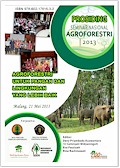| Paper |
 |
|
| Title | Media Dan Metode Komunikasi Dalam Penyuluhan Agroforestri: Studi Kasus Di Sulawesi Selatan (Kabupaten Bantaeng Dan Bulukumba) Dan Sulawesi Tenggara (Kabupaten Konawe Dan Kolaka) | | Author | Enggar Paramita, Endri Martini and James M Roshetko | | Editor | Devy Priambodo Kuswantoro, Tri Sulistyati Widyaningsih, Eva Fauziyah and Rina Rachmawati | | Year | 2013 | | Parent Title | Prosiding Seminar Nasional Agroforestri 2013. “Agroforestri untuk Pangan dan Lingkungan yang Lebih Baik”. Malang, 21 Mei 2013 | | Publisher | Balai Penelitian Teknologi Agroforestry, Fakultas Pertanian Universitas Brawijaya, World Agroforestry Centre (ICRAF) - Southeast Asia Regional Program, and Masyarakat Agroforestri Indonesia | | City of Publication | Malang, Indonesia | | Date | 2013-05-21 | | Pages | 488-493 | | Call Number | PP0341-14 | | Keywords | information, farmers, dissemination, television, radio |
|
| Abstract: |
| Presence of information can help farmers enhance the management of their agroforestry systems. In Indonesia,
the limited numbers of extension agents has become one of the reasons why information reaches finite
communities of communities. Additionally, agroforestry is a new field of which most agricultural extension
agents in Indonesia have limited knowledge and experience. Communication media -such as poster, leaflet,
books, television, and radio- hold potential for facilitating the spread of knowledge among farmers. By knowing
the media and methods preferred by farmers for receiving information could help formulate effective and
efficient extension programs. To identify it, a study interviewing 146 farmers in South Sulawesi (Bantaeng,
Bulukumba) and Southeast Sulawesi (Konawe and Kolaka) was conducted.
Data analysis shows television and cellphone as main source of information in South Sulawesi, while radio and
cellphone in Southeast Sulawesi. In both provinces, the most preferred communication method used to obtain
information is practical session, face-to-face, audiovisual, seeing, hearing, and reading. The extension media
that were mostly received by farmers in both provinces are books, leaflet, DVD/VCD, poster and calendar
poster. Media such as video, poster, books, television, and radio can reach large numbers of farmers. The usage
of television and radio as main mass communication media are recommended to disseminate information
widely. Cellphone has also great potential to serve as an effective media in the near future especially to
disseminate up to date information such as commodity price. |
|